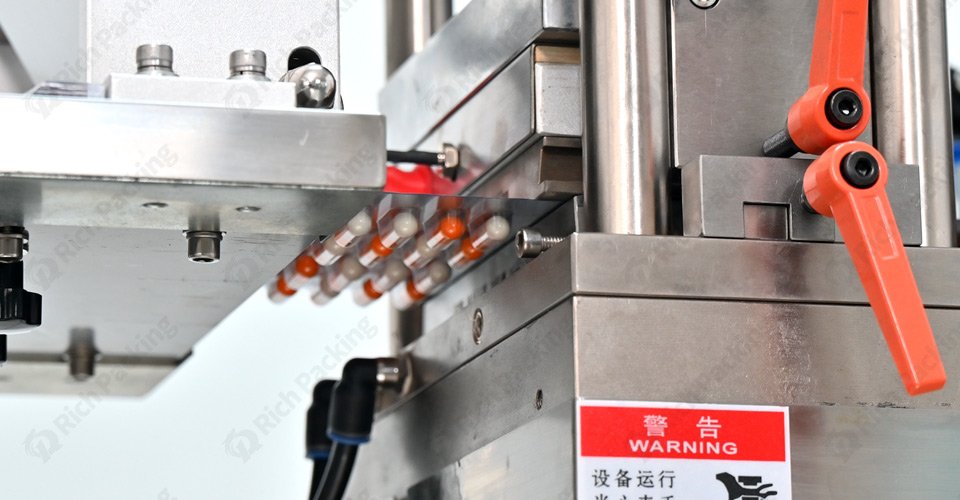Categories
New Blog
Tags
Heat sealing is a crucial step in the operation process of blister packing machine. The quality of heat sealing directly determines the sealing of the package, which in turn affects the integrity and safety of the product. If not operated properly, the product may leak and break during transportation and storage, and even affect the service life of the product. To ensure the sealing effect, you need to pay attention to the temperature, pressure and time settings during heat sealing, as well as understand how to adjust these parameters for different materials in order to achieve efficient and stable production.

The function of heat sealing is to tightly bond the packaging film through heating and pressurization to ensure that the inside of the package is isolated from the outside world. Poor sealing can result in products being exposed to air, especially in industries such as pharmaceuticals and food, where package sealing is critical. If a package is not heat-sealed tightly enough, the product is exposed to oxygen and moisture, which may accelerate spoilage or affect the effectiveness of the drug. And overheating of the seal may lead to deformation or even breakage of the packaging material. Therefore, mastering the key parameters of the heat sealing process is the basis for ensuring product quality.
When using the blister packaging machine, you may encounter a variety of heat sealing-related problems. The most common ones are poor sealing, air bubbles, uneven sealing or too tight sealing. Poor sealing may stem from insufficient temperature or pressure, resulting in a tight seal and exposed product. Air bubbles, on the other hand, can be caused by the material failing to vent completely during sealing, or by excessive pressure. Overheating of the seal can also cause problems, as the material may be deformed due to excessive bonding at high temperatures, affecting aesthetics and functionality.

In the heat sealing process of a blister packaging machine, temperature, pressure and time are the three core elements you must control precisely. The setting of these parameters not only affects the sealing effect, but also directly relates to productivity and yield.
Temperature control: The temperature of heat sealing should be set according to the characteristics of the material used. If the temperature is too low, the sealing will not be firm and the sealing will be affected. If the temperature is too high, the material may melt or deform. Different materials have different melting points, such as PVC, PET and PE, which are commonly used blister packaging materials, and they require different temperature settings for heat sealing. Make sure the temperature is right to achieve good sealing results.
Pressure regulation: Pressure also plays an important role in the heat sealing process. Too much pressure may cause the packaging material to be crushed and deformed, leaving indentations or creating air bubbles, while too little pressure may not be able to fully bond the material. Appropriate pressure ensures a flat and firm seal, maintaining a high quality seal throughout the production line.
Sealing Time: Too short a sealing time will not allow enough time for the material to fully bond and the seal will not be secure. Too long a time may cause the material to overheat and break or deform. For different material thicknesses, you need to adjust the heat sealing time according to its characteristics to ensure that neither the sealing effect nor the material damage will be affected.

Different packaging materials have different heat sealing requirements, especially the commonly used PVC, PET and PE. The heat resistance, thickness and shrinkage characteristics of each of these materials determine that they require different settings when heat sealing.
PVC materials usually require lower temperatures and moderate pressures when heat sealing because it has a low melting point and too high a temperature can cause the material to deform. PET, on the other hand, requires a relatively high temperature and high pressure to ensure the sealing effect. PE material, although soft, requires more precise temperature control and moderate pressure when heat sealing due to its easy-to-distort nature. If the packaging material is thicker, the temperature and pressure of heat sealing need to be increased accordingly to ensure that the sealing can penetrate to the inner layer.
In order to ensure the effectiveness of heat sealing, you need to master some specific operation techniques. First of all, preheating the equipment is crucial. Before starting the heat sealing, make sure the blister packaging machine has been preheated to the required temperature to avoid inconsistent sealing caused by unstable temperature. Temperature fluctuations will directly affect the sealing quality, the temperature stability of the equipment is key.
Secondly, the sealing speed is also a factor to be considered. If the sealing speed is too fast, it may not be able to give the material enough time for bonding, resulting in a poor seal. While too slow sealing speed will affect the overall production efficiency. Therefore, when setting the sealing speed, you need to make reasonable adjustments according to the production rhythm and equipment capacity.
Calibration of the equipment is also important, especially when working continuously for a long time. Regularly checking and calibrating the temperature, pressure and time settings of your equipment can help you maintain consistent sealing quality. Ensuring that the equipment's parameters are within the set range can prevent many common sealing problems.
Below are some common heat sealing problems and their corresponding solutions to help you quickly adjust your production parameters if you encounter similar problems:
|
Problem |
Cause |
Solution |
|
Weak Seal |
Low temperature or insufficient pressure |
Increase temperature or pressure |
|
Overheating and Deformation |
Excessive temperature or sealing time |
Lower temperature or shorten sealing time |
|
Bubbles |
Excessive pressure or dirty materials |
Reduce pressure or clean sealing materials |
|
Uneven Sealing |
Uneven material distribution or fast sealing speed |
Check material distribution, slow down speed |
By reasonably adjusting these parameters, it can help you quickly solve the heat sealing problem and improve the quality and productivity of the package.
In order to ensure the long-term operation of the blister packaging machine, the maintenance and upkeep of the equipment should not be neglected. You need to clean the heat sealing parts of the equipment regularly, especially the sealing area, to avoid impurities affecting the sealing effect. Material residue or dust may lead to poor sealing and increase the rate of defective products.
In daily operation, regularly check whether the parameters of the equipment are functioning properly, especially whether the temperature and pressure sensors are accurate. Timely troubleshooting when sealing problems are detected can prevent problems from accumulating and causing greater production losses. Low sealing temperatures or insufficient pressure may result in poor sealing, and these problems can usually be avoided through regular maintenance and testing.
To ensure the sealing quality of each product, you can introduce an in-line inspection system to monitor the sealing situation in real time during the production process. With the visual inspection system, you can detect bad sealing problems in time and avoid unqualified products from entering the downstream process. Meanwhile, regular sealing strength tests can ensure the firmness and durability of the seal. These measures can help you maintain high-quality packaging standards during the production process and reduce the rate of defective products and rework costs.
Mastering the precautions of heat sealing in blister packaging machines can effectively improve the packaging quality of your products and reduce problems in the production process. By accurately controlling temperature, pressure and time, and performing regular maintenance on your equipment, you can ensure that every batch of product is packaged to meet standard requirements, ensuring product integrity and safety.